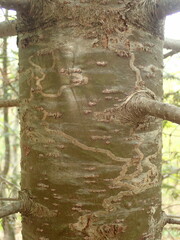Distinguishing leaf mines from things that aren't mines
Someone just asked me, "Any general advice on distinguishing leafminers from other leaf blights?" I figured it was worth copying my reply here for future reference.
To get a search image, you can peruse the observations in this project:
https://www.inaturalist.org/projects/leafminers-of-north-america
Ideally, anything you think might be a leaf mine should be viewed/photographed from both leaf surfaces in reflected light as well as in transmitted light. If it is truly a mine, it will have both epidermises intact, and it will either contain a larva/pupa or have a hole/slit in one epidermis through which the larva or adult exited. It also will typically have visible frass inside, unless it is a species that expels its frass through a hole/slit in one epidermis.
As for distinguishing leaf mines from other types of insect feeding, it's clear from some of the observations that have been added to this project, or have been given the "leafmine" evidence of presence annotation, that not everyone is clear on what defines a leafminer. Leafmining is not a general term for eating leaves; it refers exclusively to insect larvae feeding inside leaves, between the two epidermises. A hole in a leaf is not a mine, nor is feeding sign with only one epidermis left intact (this is called "window-feeding"). If you see a bug on the surface of a leaf, it is not mining***! If a larva is feeding between two leaves that are tied together, or within a rolled or folded leaf, that also isn't mining (although some mines can cause the edges of leaves to curl/fold).
I made a key to the different feeding modes of herbivorous insects in the third edition of Leafminers of North America, but the information above should be all you need to decide if something is mining or not.
*** (unless it is extending the front of its body into the leaf to feed, as is done by Coleophora casebearers and a few other things.)




















